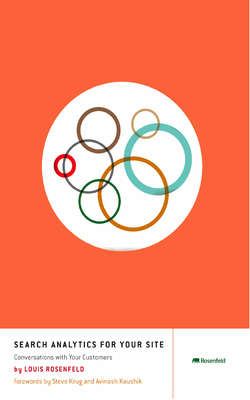Читать книгу Search Analytics for Your Site - Louis Rosenfeld - Страница 28
На сайте Литреса книга снята с продажи.
Ways to Use SSA (and This Book)
ОглавлениеSo what’s the message here? That SSA is an incredibly important tool for helping you understand what users want from your site. And once you have a sense of what they want, you can evaluate and improve all sorts of things that are there to help users get what they want. For instance, you can improve your site as follows:
Search system: SSA will help you understand how people entered searches, where they were when they entered them, and how they interpreted the search results. (We cover this in Chapter 8.)
Navigation and metadata: Do certain pages generate a lot more search activity than others? What kinds of searches? And does this suggest that certain navigational options are missing or labeled in a confusing way? SSA will also give you tips on how to shore up your site’s navigation and metadata. (We cover this in Chapter 9.)
Content: For example, you can study queries that retrieve zero results. Is this because there isn’t content on the topic? Should there be? Or is the relevant content mistitled? Or poorly written? SSA will help you determine what content is missing and what to do to existing content to make sure it gets found. (We cover this in Chapter 10.)
Whatever design challenges you face, SSA—like any other data analysis—will back up your design decisions with actual facts.
Of course, as much as you’d like to make users happy, you also have to make your employers happy. They have goals—for your organization and for the site itself. (They ought to, at least.) These can be expressed and measured as KPI—Key Performance Indicators. The types of search-related metrics that you saw in Chapter 1 can serve as components to these KPIs—in fact, many organizations that are otherwise sophisticated in their measurement of performance often fall down when it comes to measuring findability. In Chapter 3, we’ll help you do what John Ferrara did: use goal-based analysis to measure, monitor, and optimize performance, again and again.
Finally, there are some other important ways to analyze search data:
Pattern analysis: What patterns emerge when you “play” with the data? Can you use those patterns to determine what types of metadata and content are the most important to your searchers? Can you detect changes in seachers’ behavior and needs that are seasonal? Do you also find instructive surprises and outliers? (We cover this in Chapter 3.)
Failure analysis: When searches return no results—or poor results—what can we learn? And what can we do to fix those problems and improve performance? (We cover this in Chapter 4.)
Session analysis: What happens during a specific search session? How do searchers’ needs and understanding of the content change as they search? (We cover this in Chapter 5.)
Audience analysis: How might we uncover the differences between audience segments and their information needs? And how might we better address those differing needs? (We cover this in Chapter 6.)
